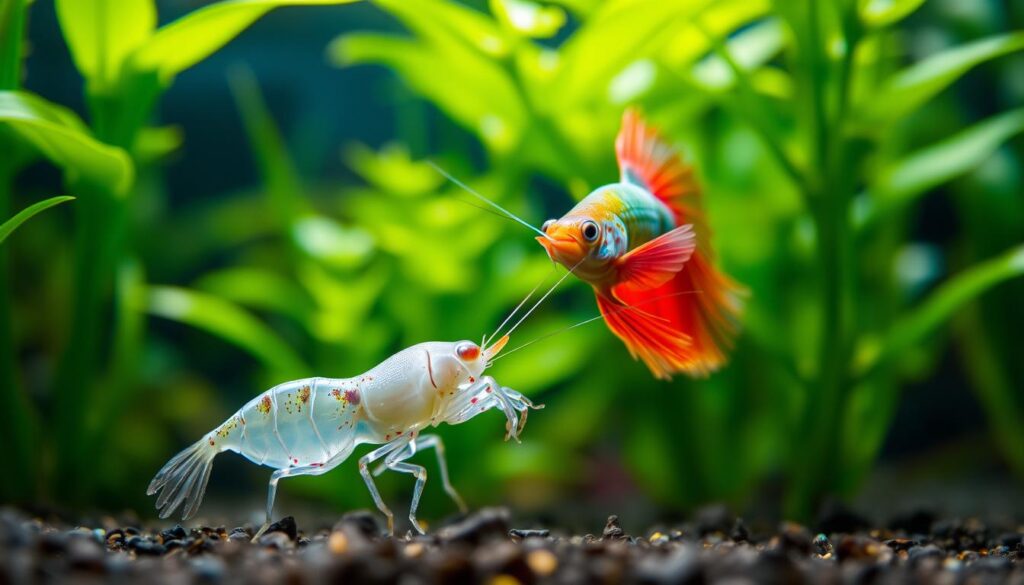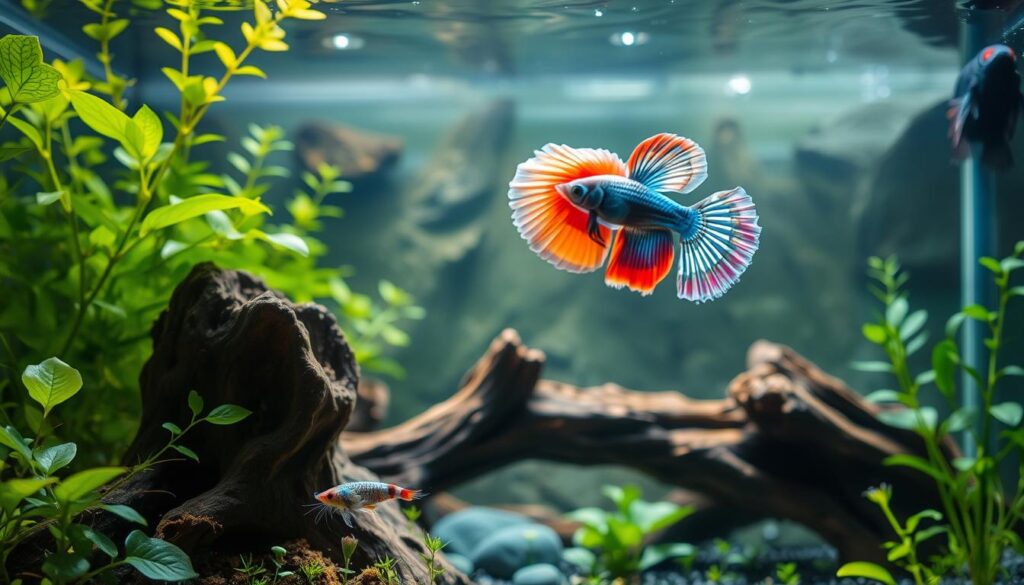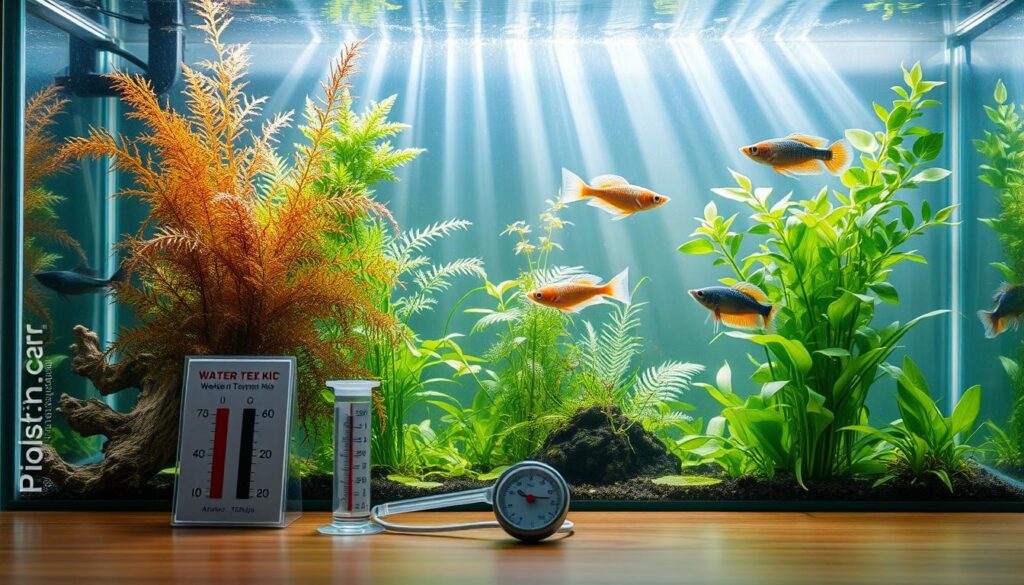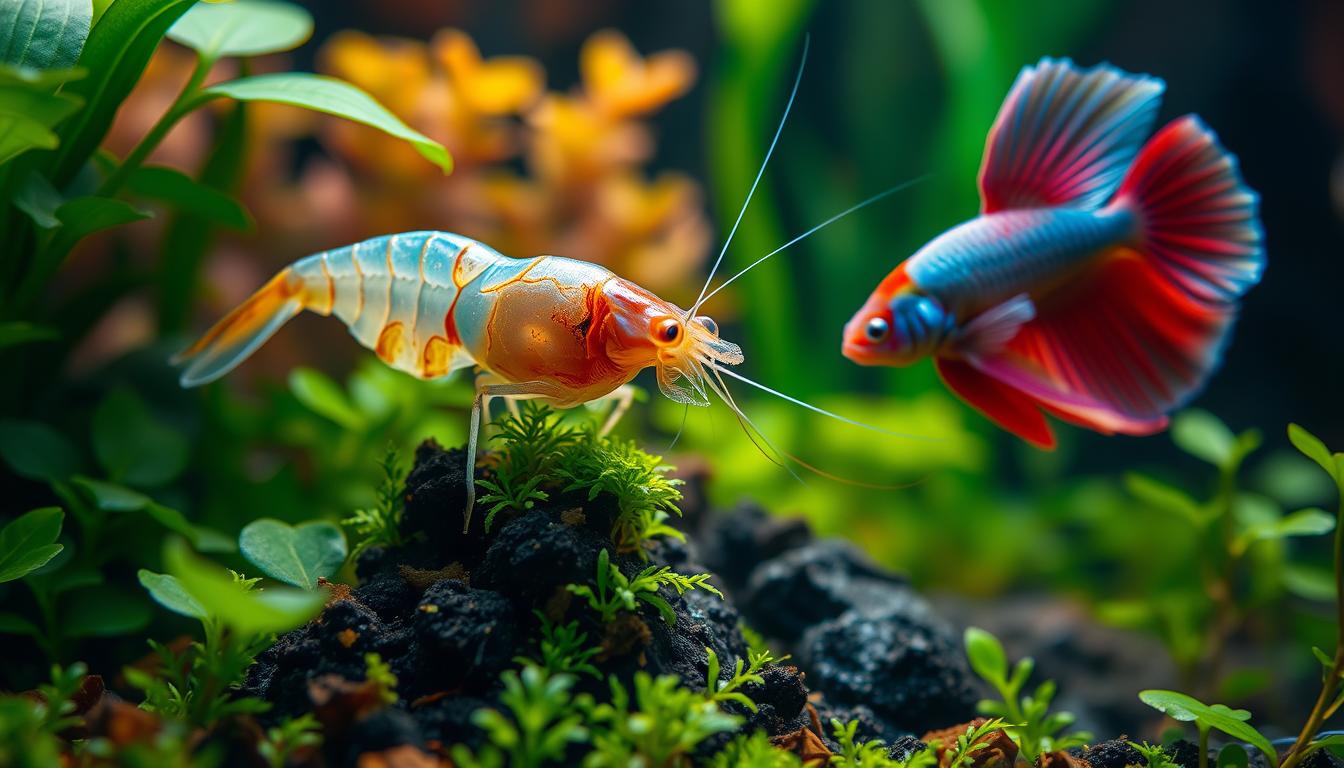Are you wondering if Amano shrimp can thrive in the same tank as your betta fish? You’re not alone! Many aquarium enthusiasts are curious about the compatibility of these two popular species.
Did you know that some aquarium owners have successfully kept Amano shrimp and betta fish together, while others have reported conflicts? The answer to whether they can coexist peacefully depends on several factors, including the shrimp species, your betta’s temperament, and how you introduce them.
So, can betta fish live with shrimp safely? Let’s explore the ins and outs of keeping these two species together and provide you with tips for successful cohabitation.
Key Takeaways
- Understand the compatibility of Amano shrimp and betta fish before introducing them.
- Choose the right shrimp species for cohabitation with betta fish.
- Consider your betta’s temperament when introducing Amano shrimp.
- Learn how to introduce Amano shrimp to your betta tank successfully.
- Be aware of common challenges when keeping Amano shrimp and betta fish together.
Understanding Amano Shrimp: Characteristics and Natural Habitat
Let’s explore the Amano shrimp, a favorite among aquarium fans. They’re known for their unique traits and natural ways of living. You might wonder what’s so special about them. We’re about to find out!
Physical Characteristics and Lifespan
Amano shrimp stand out for their size and looks. But what do they look like, and how long do they live in your tank?
Size, Appearance, and Distinctive Features
Amano shrimp can grow up to 2 inches long. They’re among the bigger shrimp you can keep in your tank. Their bodies are clear, with white or yellowish stripes or spots. These can change based on their food and where they live. Their fast speed and algae-eating skills make them perfect for betta tanks!
With the right care, Amano shrimp can live for many years. They usually live between 2 to 5 years. This depends on the water quality, their food, and the tank’s conditions.
| Characteristic | Description |
|---|---|
| Size | Up to 2 inches |
| Appearance | Transparent body with white or yellowish stripes/spots |
| Lifespan | 2-5 years |
Betta Fish: Personality Traits and Natural Behavior
Thinking about getting a betta fish? It’s key to know their unique traits and how they act naturally. Betta fish stand out with their bright colors and lively personalities. But, what makes them sometimes seem so feisty?
Betta fish are not just pretty; they also have distinct personalities. Their actions are shaped by their natural instincts and how they feel as individuals. Knowing this helps you care for them better and keep peace in a shared tank.
Betta Aggression: Myths vs. Reality
There’s a lot of talk about betta aggression. It’s true they can fight, but they’re not always aggressive. The truth is, betta aggression often comes from specific situations, like defending their space or being naturally more aggressive.
Understanding Territorial Behavior
Betta fish naturally want to protect their territory. In the wild, they fight off other bettas and rivals. In a home tank, they might see other fish or reflections as threats. Giving them lots of hiding spots and visual barriers can help reduce this territorial urge.
Individual Temperament Variations
Just like any pet, betta fish have their own unique personalities. Some are calm, while others are more spirited. Knowing that each betta is different is key. Watching how your betta acts and adjusting your care can really help.
Amano Shrimp and Betta Fish Compatibility Factors
Can Amano shrimp and betta fish live together? Let’s look at what makes them compatible. Their success depends on knowing their unique needs and traits.
Size Differential and Predation Risk
The size gap between Amano shrimp and betta fish is key. Bettas might see shrimp as food, especially if they’re hungry or aggressive. Amano shrimp are small, so a big betta might see them as a meal. You must consider your betta’s nature.
Behavioral Interactions in Shared Spaces
How Amano shrimp and betta fish act together is crucial. Bettas are territorial, while shrimp are peaceful. Watch them closely when they first meet. Giving shrimp plenty of places to hide can help reduce stress and prevent aggression.
Environmental Requirement Overlap
Both Amano shrimp and betta fish need certain conditions to thrive. They both like warm water, but betta fish can handle a bit wider temperature range. It’s important to make sure the tank meets both their needs. For example, shrimp need oxygen-rich water with lots of plants, which betta fish also enjoy.
| Compatibility Factor | Amano Shrimp | Betta Fish |
|---|---|---|
| Size | Small (1-2 inches) | Medium (2-3 inches) |
| Behavior | Peaceful, social | Territorial, aggressive |
| Water Temperature | 72-82°F (22-28°C) | 76-82°F (24-28°C) |

Understanding these factors can help you create a peaceful home for both Amano shrimp and betta fish. It’s about finding the right balance and paying attention to their needs.
Ideal Tank Setup for Successful Cohabitation
Setting up a tank for Amano shrimp and betta fish needs careful planning. You want a place where both can thrive. Let’s explore the key elements for a successful tank setup.
Minimum Tank Size Requirements
A larger tank (5 gallons or more) is key for successful cohabitation. It offers enough space for both species to live without feeling cramped. A 5-gallon tank allows for a diverse and engaging aquascape.
Essential Equipment and Filtration
A good filtration system is crucial. You need a filter that can handle the tank’s volume and keep the water clean. Choose a filter with adjustable flow rates for both Amano shrimp and betta fish. A sponge filter or a gentle hang-on-back filter is a good choice.

Aquascaping for Harmony: Plants and Hiding Spots
Aquascaping is more than looks; it’s about creating harmony. Plants and hiding spots reduce stress and provide territorial boundaries.
Best Plants for Amano Shrimp Safety
Choose plants that are safe for Amano shrimp and offer hiding spots. Java Moss, Anubias, and Amazon Swords are great options. They’re safe for Amano shrimp and help keep the water quality good.
Creating Territorial Boundaries
To reduce aggression, create territorial boundaries with plants, rocks, and driftwood. This lets your betta fish have its territory without disturbing the Amano shrimp. A well-structured aquascape is crucial for peace in your tank.
| Plant Type | Amano Shrimp Safety | Benefits |
|---|---|---|
| Java Moss | Safe | Provides hiding spots, helps with algae control |
| Anubias | Safe | Easy to care for, provides shade |
| Amazon Swords | Safe | Provides shelter, helps maintain water quality |
Introducing Amano Shrimp to Your Betta Tank
Adding Amano shrimp to your Betta tank is exciting. But, it needs careful planning. You must acclimate the shrimp right and adjust the tank environment.
Proper Acclimation Techniques
Acclimating your Amano shrimp is key for their survival. Use the drip acclimation method to slowly adjust them to the tank’s water.
Drip Acclimation Method
The drip acclimation method mixes the transport water with tank water slowly. This takes hours but is crucial to avoid shocking the shrimp.
Timing and Temperature Considerations
Ensure the transport and tank temperatures match before acclimation. Use a thermometer to check and adjust if needed.
| Acclimation Step | Description | Time |
|---|---|---|
| 1. Float the bag | Let the sealed bag float in the tank for 15-20 minutes. | 15-20 minutes |
| 2. Drip acclimation | Start dripping tank water into the bag at 1-2 drops per second. | 1-2 hours |
| 3. Release | Gently release the shrimp into the tank. | – |
Monitoring First Interactions
Watch closely after introducing the Amano shrimp. Look for stress or aggression signs like fin nipping or hiding.
Signs of Stress or Aggression
Aggressive behavior needs quick action. Watch for rapid breathing, hiding, or the Betta chasing the shrimp.
When to Intervene
If aggression doesn’t stop, separate the Betta and shrimp or rearrange the tank for more hiding spots.

Feeding Strategies for a Shared Tank
To keep Amano shrimp and betta fish together, you need to feed them right. They have different food needs. Let’s find out how to feed them well!
Nutritional Needs of Amano Shrimp
Amano shrimp love to eat algae and biofilm. They also enjoy algae wafers as a treat.
Algae, Biofilm, and Supplemental Foods
Make sure your Amano shrimp have lots of algae and biofilm to eat. You can also give them algae wafers or spirulina-based foods.
Betta Feeding Guidelines
Betta fish are meat-eaters and need a lot of protein. Give them high-quality betta pellets or live/frozen foods like brine shrimp.
Protein Requirements and Feeding Frequency
Bettas should eat 2-3 times a day. Focus on protein-rich foods. Don’t overfeed, as it can harm their health.
Preventing Food Competition
To stop them from fighting over food, use target feeding. Also, have a feeding schedule for both species.
Target Feeding Techniques
Feed your betta directly with a pipette or near them. For Amano shrimp, put algae wafers on the substrate.
Feeding Schedules and Locations
| Species | Food Type | Feeding Frequency |
|---|---|---|
| Amano Shrimp | Algae, Biofilm, Algae Wafers | Continuous grazing, supplemented daily |
| Betta Fish | High-protein betta pellets, live/frozen foods | 2-3 times a day |

Maintaining Water Quality in a Mixed Species Tank
To keep a mixed tank thriving, focus on water quality! Caring for amano shrimp and betta fish together is like managing a delicate ecosystem. It needs attention and a commitment to the best conditions.
Optimal Water Parameters for Both Species
Amano shrimp and betta fish have similar water needs. Aim for a pH of 6.5 to 7.5 and a temperature of 76°F to 82°F (24°C to 28°C). Staying consistent with these parameters is key to avoid stressing your pets.
Cleaning and Maintenance Schedule
Regular tank upkeep is essential for water quality. Check water parameters weekly and do partial water changes every 1-2 weeks. Also, clean your filter as directed to avoid debris buildup.
Water Change Best Practices
Water changes are important in a mixed tank. Changing about 25% of the water every 2 weeks is a good start.
Frequency and Volume Recommendations
Adjust the change frequency and volume based on your tank’s needs. Consider the bioload and filtration efficiency.
Safe Water Conditioning Methods
Always use a water conditioner to remove chlorine and chloramines from tap water. This makes the new water safe for your pets.

Troubleshooting Common Problems
Keeping Amano shrimp and betta fish together can sometimes lead to unexpected challenges. We’ll explore common problems and offer solutions to help you overcome them.
Addressing Betta Aggression Toward Shrimp
Betta fish are territorial and may be aggressive toward Amano shrimp. If you see your betta being aggressive, act quickly.
Intervention Strategies
To tackle betta aggression, add more plants or decorations for hiding spots. This reduces stress and provides safety for the shrimp. You can also rearrange the tank to block the betta’s view of the shrimp.
When to Separate Species
If aggression persists and shrimp are harassed or injured, separate them. Set up a separate tank for the shrimp or use a divider.
Shrimp Health Issues in Betta Tanks
Amano shrimp are generally hardy but can face health issues in a betta tank. Poor water quality, inadequate nutrition, and stress can cause problems. Regular water changes and a balanced diet help keep shrimp healthy.
Managing Molting Stress and Complications
Amano shrimp molt as they grow, which can be stressful. Poor water quality or lack of calcium can lead to complications. Maintain good tank water and provide a calcium-rich diet or supplements if needed.
By understanding these common problems and taking steps to prevent or address them, you can create a harmonious and thriving community tank for both your Amano shrimp and betta fish.
Benefits of Keeping Amano Shrimp with Bettas
Keeping Amano shrimp with betta fish has many benefits. It creates a thriving, balanced ecosystem in your aquarium. Let’s explore the advantages of this combination.
Algae Control and Tank Maintenance
Amano shrimp are known for eating algae. They make your betta tank cleaner by eating algae. This means you don’t have to change the water as often, keeping your betta healthy.
Algae control is a big plus. With Amano shrimp, algae growth decreases. Your tank will look great.
Behavioral Enrichment for Bettas
Adding Amano shrimp to your betta tank is good for your betta. It makes them active and engaged. Your aquarium will be more interesting.
Creating a Balanced Ecosystem
Introducing Amano shrimp to your betta tank makes it more diverse. This balance is key for both species’ health. A balanced ecosystem is more resilient and can handle changes better.
| Benefits | Description |
|---|---|
| Algae Control | Amano shrimp eat algae, reducing the need for frequent water changes. |
| Behavioral Enrichment | The presence of Amano shrimp stimulates betta’s natural hunting instincts. |
| Balanced Ecosystem | Amano shrimp and betta fish create a diverse and resilient aquarium ecosystem. |
Conclusion: Creating a Thriving Community Tank
Amano shrimp and betta fish can live well together in a community tank. By following the tips in this article, you’re on the right path. You’ll create a beautiful space for both species to thrive.
Keeping these two species together needs careful planning and attention. Knowing their needs helps you create a balanced home for them. This way, both your Amano shrimp and betta fish will do great.
The secret to a thriving tank is finding the right balance. It also means giving your best to care for your fish and shrimp. With patience and the right advice, you can have a stunning tank with Amano shrimp and betta fish.

